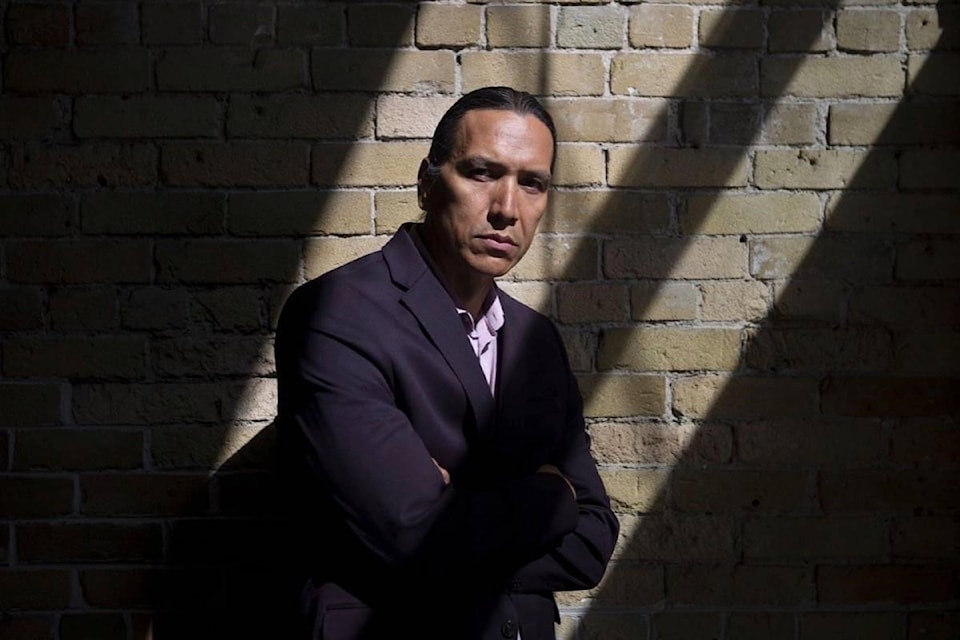TORONTO — Zombies are often used in pop culture as a metaphor for collective fears and threats, including infectious disease and its effects on the body and society.
So as the Canadian film “Blood Quantum” hits on-demand and digital platforms on Tuesday, with its look at a fictional First Nations community immune to a zombie plague that’s broken out, it has chilling parallels with the COVID-19 pandemic as well as other recent events.
“The idea of immunity and infection, and how we have to be scared of others — people who might infect us, and who’s sick and who’s not sick — all of a sudden took on a deadly kind of seriousness,” star Michael Greyeyes said in a recent phone interview from his Toronto home.
“And I think when audiences look at this film, they’ll go, ‘Wow, this is about us. This is about our experiences. This is about xenophobia and racism and an unspoken sense of dread.’ I think audiences are going to love it.
“I hope it doesn’t exacerbate its own sort of existential terror. But that’s why we go to horror films in the first place.”
“Blood Quantum” debuted at last September’s Toronto International Film Festival and was supposed to hit theatres last month. But in a strange twist of fate, COVID-19 shutdowns prevented that from happening, hence Tuesday’s VOD release.
Montreal-based Mi’gmaq writer-director Jeff Barnaby started developing the film 13 years ago as a cultural critique, to contextualize colonialism and the dynamic of First Nations people within the confines of post-colonial society.
He also wanted to show the societal effects of pandemics, including xenophobia and paranoia.
The setting — an isolated Mi’gmaq reserve inundated with outsiders who aren’t immune and pose a threat to the community as they seek refuge from the plague — is meant to symbolize systemic issues including violent oppression, trauma and forced assimilation faced by Indigenous people.
Greyeyes plays the police chief at the fictional Red Crow Indian Reservation. Elle-Maija Tailfeathers plays a nurse at a hospital where patients start turning into zombies.
Other cast members include Forrest Goodluck, Kiowa Gordon, Kawennahere Devery Jacobs, and Olivia Scriven.
“I think there’s something about the end-of-the-world apocalypse that’s been in the zeitgeist for a long time,” said Greyeyes, a Plains Cree choreographer, director and educator who founded the non-profit theatre organization Signal Theatre in Toronto.
“We’re kind of looking at late-stage capitalism and environmental destruction. And I hope the film helps people see that in a more urgent way.”
The film’s title refers to the controversial practise of determining Indigeneity based on the percentage of one’s Indigenous ancestry.
At one point in the story, the First Nations community sets up blockades to keep the infected away. Such imagery is reminiscent of recent blockades over oil and gas pipelines across Canada.
Another coincidentally timely parallel: the danger of non-Indigenous people bringing the infection to the Red Crow reserve is much like the danger those with COVID-19 pose to vulnerable and remote First Nations, Inuit and Metis communities.
“It’s the plot of our movie playing out on the news. It’s kind of blowing my mind,” said Greyeyes.
“When the film first premiered at TIFF, I was like, ‘Indigenous communities have been facing this kind of terror for a long time — outsiders, disease, surviving plague after plague, whether it’s violence or whether there’s actual disease.’ So we’ve been surviving for a long time.”
Barnaby’s previous projects include the 2013 feature “Rhymes for Young Ghouls” and the Genie-nominated short film “File Under Miscellaneous.”
Greyeyes said he was struck by the literary writing, emotional power and depiction of strong female characters in the script for “Blood Quantum,” which was shot in Quebec in spring 2018.
Of course, this being a zombie movie, there are also entertaining moments of gore and humour to serve horror fans.
“The film is like a ride in a stolen car,” Greyeyes said, likening it to Quentin Tarantino’s work.
“It’s fun, it’s fast, it’s dangerous.”
Being on set with the undead, day after day, also took a toll.
“It was just gruelling — a lot of night shoots covered in blood covered in gore,” Greyeyes recalled.
“It was cold that spring, so I remember thinking, ‘Man, this is tough. It’s like a war movie.’ It’s very similar to working on a set in a war zone. And also just emotionally it was quite taxing.
“I didn’t realize until after the film was over, but when each day is the end of the world on a set, it can really wear on you.”
This report by The Canadian Press was first published April 27, 2020.
